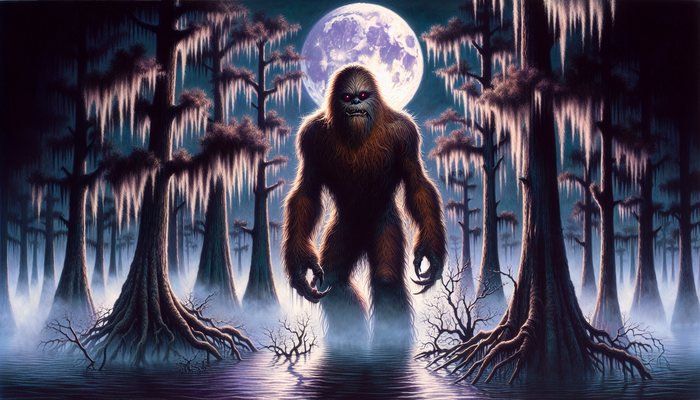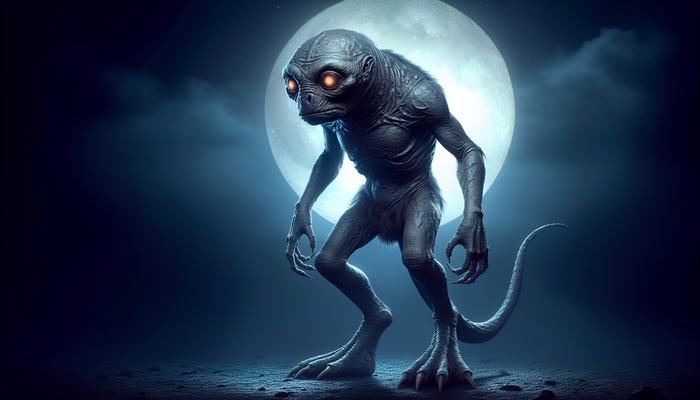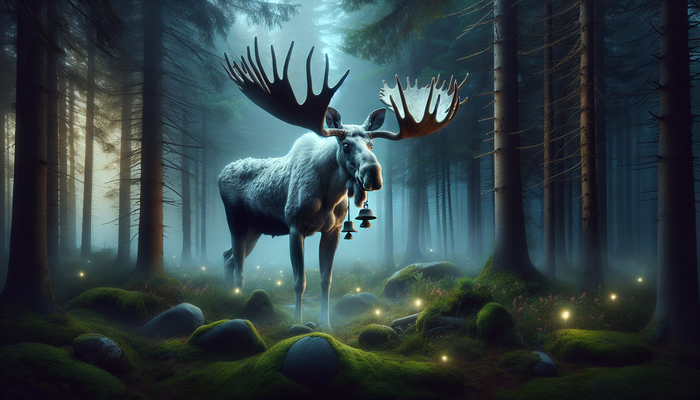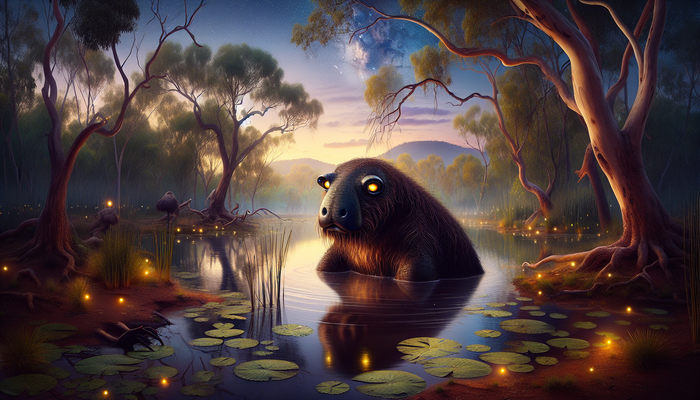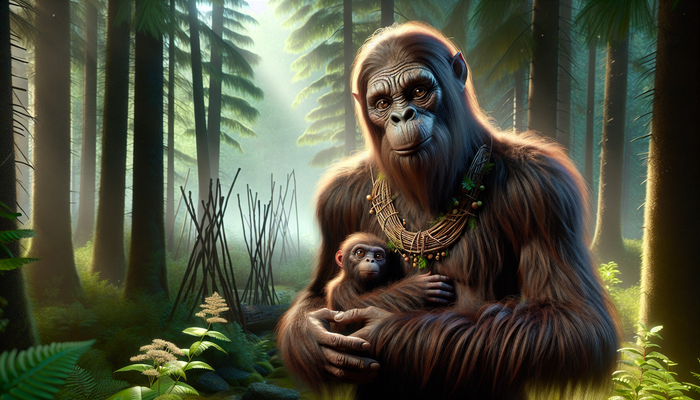The Kouilou Spider: Cryptozoology's Congolese Giant
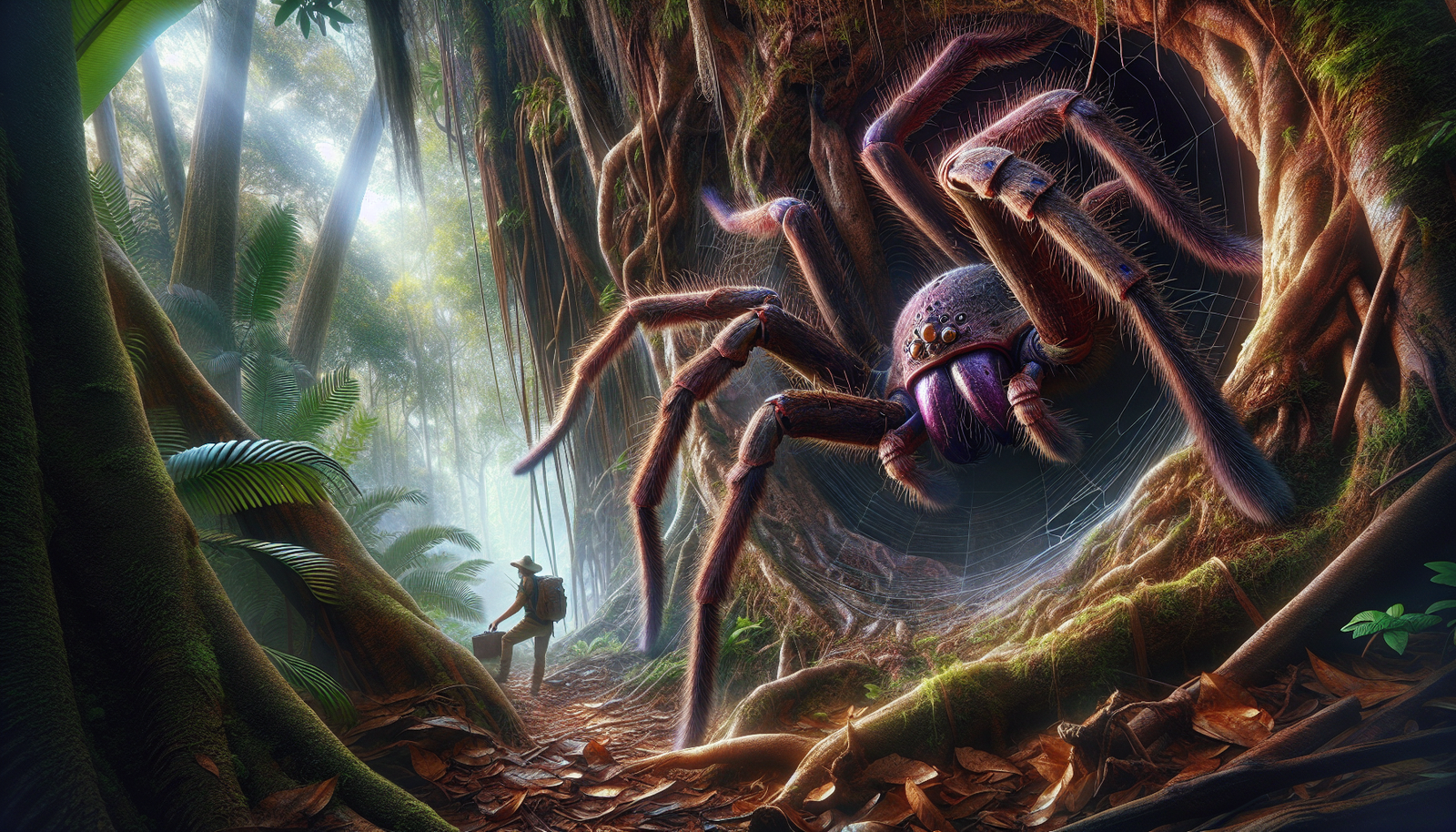
By James Roberts, Cryptozoologist
Legends of Giant Spiders
There's something about oversized arachnids that both captivates and terrifies us. As someone who has spent countless hours exploring the most remote corners of our planet in search of cryptozoological wonders, I've heard my fair share of tales about giant spiders lurking in the shadows. But few have intrigued me as much as the legend of the kouilou spider, a purported behemoth said to inhabit the dense rainforests of the Congo Basin.
This cryptid has captured the imaginations of explorers, researchers, and indigenous peoples alike, weaving a tantalizing web of mystery that spans decades, if not centuries. The mere thought of a spider with a leg span stretching up to five feet across is enough to send shivers down the spine of even the bravest among us. It taps into that primal fear that so many of us harbor, that instinctive aversion to creepy crawlies blown up to monstrous proportions.
But is the kouilou spider mere myth, the product of overactive imaginations and the human penchant for embellishment? Or could there be more to this cryptozoological legend than meets the eye? As someone who has dedicated my life to unraveling the mysteries that dwell in the wild places of our world, I couldn't resist the allure of this enigmatic arachnid. Join me as we delve into the history, eyewitness accounts, and theories surrounding one of cryptozoology's most fascinating cases - the giant spider of the Congo.
The Kouilou Spider: Descriptions and Eyewitness Accounts
To begin unraveling the mystery of the kouilou spider, we must first examine the accounts of those who claim to have encountered this elusive creature. The indigenous peoples of the Congo Basin, particularly the pygmy tribes, have long spoken of a giant arachnid they call the "J'ba FoFi" or "great spider." These oral histories offer a tantalizing glimpse into the possible characteristics and behaviors of this cryptid.
According to native descriptions, the kouilou spider is a formidable sight to behold. With a leg span that can reach up to five feet in diameter, it dwarfs even the largest known spider species, such as the giant huntsman, which maxes out at around a foot in leg span. Eyewitnesses describe the kouilou spider as having a brown, hairy body reminiscent of a tarantula, but with a distinctive purple sheen on its abdomen that sets it apart.
But it's not just the kouilou spider's size that makes it so intimidating. Indigenous accounts paint a picture of a highly adapted ambush predator with a hunting strategy not unlike that of the notorious trapdoor spiders. The kouilou spider is said to construct burrows beneath the roots of trees, which it camouflages with a veil of leaves and debris. Near this lair, it spins an expansive web, crisscrossed with trip lines that alert the arachnid to passing prey. When an unsuspecting victim stumbles into this nearly invisible snare, the kouilou spider erupts forth with startling speed to subdue and envenomate its catch.
One of the most compelling eyewitness accounts of the kouilou spider comes from a 1938 incident involving an English couple driving through what was then the Belgian Congo. As they navigated a jungle trail, a massive brown shape darted across the road in front of them. At first, they assumed it to be a monkey or small cat, but as they drew closer, the couple realized to their horror that they were looking at a spider with a leg span of nearly three feet. The creature quickly vanished into the dense undergrowth, leaving the shocked eyewitnesses questioning what they had just seen.
Decades later, cryptozoologist William Gibbons would mount several expeditions to the Congo Basin in search of the kouilou spider and other cryptids said to inhabit the region. During his investigations, Gibbons interviewed members of the local pygmy tribes, who provided detailed accounts of their own encounters with the J'ba FoFi. The native hunters described the great spider's appearance and habits with a striking consistency, lending credence to the possibility that a real creature might underlie these tales.
Intriguingly, the pygmies noted that sightings of the kouilou spider seemed to be growing increasingly rare in recent years. They speculated that the arachnids might be moving their lairs higher into the forest canopy, perhaps in response to increasing human encroachment into their habitat. While the tribes had traditionally given these spiders a wide berth, they would occasionally kill one if it posed a threat to their settlements. The pygmies' reverence and fear of the kouilou spider was palpable, hinting at a long history of coexistence with this mysterious creature.
Habitat and Range: The Congolese Rainforests
To understand the plausibility of a creature like the kouilou spider existing undetected for so long, we must consider the environment in which it is said to reside. The Congo Basin is home to one of the Earth's largest and most biodiverse rainforests, second only to the Amazon in size. This vast expanse of tropical wilderness remains one of the least explored regions on the planet, with much of its interior still largely untouched by modern civilization.
The dense canopy and understory of the Congolese rainforests create a labyrinth of shadows and hidden places, where countless species thrive in the humid, nutrient-rich environment. From the elusive okapi to the recently discovered Congo peacock, this ecosystem has a proven track record of harboring creatures that have long evaded scientific description. In fact, new species are being identified in the Congo Basin with astonishing regularity, often overturning long-held assumptions about what kind of life might inhabit these forests.
But as extraordinary as the biodiversity of the Congolese rainforests is, it is also increasingly under threat. Deforestation, driven by logging, mining, and agricultural expansion, is eating away at the margins of this wilderness, fragmenting habitats and pushing species to the brink of extinction. Poaching and the bushmeat trade are also taking a heavy toll, as the growing human population around the Congo Basin turns to the forest for sustenance and income.
In this context, it's not hard to imagine that a creature as elusive and potentially rare as the kouilou spider could have slipped through the cracks, evading scientific detection while its habitat slowly disappears. If such a species does exist, it may well be critically endangered, clinging to survival in the most remote corners of the rainforest where human encroachment has not yet reached.
The prospect of losing a creature as remarkable as the kouilou spider before it can even be properly documented is a sobering thought, and one that underscores the urgent need for conservation efforts in the Congo Basin. As we delve deeper into the theories surrounding this cryptid's existence, it's important to keep in mind the fragility of the ecosystem it calls home, and the very real possibility that time may be running out to unravel its secrets.
Possible Explanations and Theories
As intriguing as the eyewitness accounts and native legends surrounding the kouilou spider are, they remain anecdotal evidence at best. Without a physical specimen or clear photographic proof, the scientific community has been understandably hesitant to embrace the existence of a spider of such extraordinary size. But that hasn't stopped cryptozoologists and other researchers from proposing a range of theories to explain the kouilou spider phenomenon.
One possibility is that the kouilou spider represents a previously undiscovered species of arachnid, one that has managed to evade scientific description due to its rarity and the inaccessibility of its habitat. While the idea of a five-foot spider might seem far-fetched, it's worth noting that there are precedents for surprisingly large arachnids. The giant huntsman spider, for instance, was only discovered in 2001 in a remote cave in Laos, and boasts a leg span of up to a foot in diameter.
Could the kouilou spider be a similar case of a secretive species that has managed to fly under the radar of scientific exploration? It's not outside the realm of possibility, especially given the vastness and relative inaccessibility of the Congo Basin rainforests. However, the lack of any physical evidence, such as a preserved specimen or even a clear photograph, does raise questions about the likelihood of such a large spider going undetected by researchers and locals alike.
Another intriguing, if somewhat more speculative, theory is that the kouilou spider could be a surviving relic of a prehistoric arachnid lineage. During the Carboniferous period, around 300 million years ago, the Earth's atmosphere was significantly richer in oxygen than it is today. This allowed for the evolution of invertebrates of truly monstrous proportions, including the likes of Megarachne servinei, a spider-like creature with a body length of nearly two feet.
While these ancient giants went extinct millions of years ago, the idea that a remnant population might have persisted in the sheltered environment of the Congo Basin is an alluring one. It would certainly help to explain the kouilou spider's purported size, which far exceeds that of any known modern arachnid. However, without fossil evidence or genetic data to support this hypothesis, it remains firmly in the realm of speculation.
Of course, we must also consider the possibility that the kouilou spider legend is based on misidentifications or exaggerations of more prosaic natural phenomena. Some researchers have suggested that eyewitness accounts could be attributed to sightings of unusually large specimens of known spider species, such as the giant huntsman or the Goliath birdeater. Others have pointed to the social behavior of certain arachnids, which can form dense aggregations and spin communal webs that might be mistaken for the work of a single, gigantic spider.
There's also the inescapable role that fear and imagination can play in shaping our perceptions of the natural world. Spiders have long been objects of primal dread for many people, and the idea of a giant, venomous arachnid lurking in the shadows taps into some of our deepest anxieties. It's not hard to see how a glimpse of a large spider in the dim light of the rainforest might be transformed into something truly monstrous in the retelling, especially when filtered through the lens of cultural mythology.
Indeed, the kouilou spider occupies a unique place in the folklore of the Congo Basin, straddling the line between the natural and the supernatural. To the indigenous peoples of the region, this creature is more than just an animal - it is a powerful symbol of the untamed wilderness, a guardian of the forest's secrets and dangers. In this context, the kouilou spider takes on a quasi-mythical status, a representation of the primal forces that still hold sway in one of the Earth's last true frontiers.
Ongoing Cryptozoological Investigations and Challenges
Despite the lack of concrete evidence, the legend of the kouilou spider continues to captivate cryptozoologists and inspire new generations of researchers to venture into the heart of the Congo Basin in search of answers. William Gibbons' expeditions in the 1990s and early 2000s helped to bring international attention to the phenomenon, and other investigators have followed in his footsteps, interviewing eyewitnesses and scouring the rainforest for signs of the elusive arachnid.
But the challenges facing these intrepid researchers are formidable. The dense, often impenetrable vegetation of the Congo Basin makes exploration a daunting prospect, and the lack of infrastructure in many areas means that expeditions must be largely self-sufficient, carrying in all their own supplies and equipment. The climate, too, takes its toll, with sweltering heat, oppressive humidity, and frequent downpours that can turn the forest floor into a muddy quagmire.
Perhaps the greatest obstacle, however, is the sheer vastness of the area that needs to be searched. The Congo Basin covers an area of over 1.5 million square miles, and much of it remains unmapped and poorly understood. Finding a creature as elusive as the kouilou spider in this endless expanse of green would be akin to locating a needle in a haystack - a task made all the more daunting by the spider's nocturnal habits and talent for camouflage.
In the absence of clear photographic or video evidence, cryptozoologists have had to rely heavily on eyewitness testimony and the knowledge of indigenous peoples to guide their search. This approach has its own challenges, as the line between fact and folklore can often blur in the oral histories of the Congo Basin tribes. Separating reliable accounts from tall tales and exaggerations requires a keen eye and a deep understanding of the cultural context in which these stories are told.
There's also the question of what constitutes valid evidence in the field of cryptozoology. While mainstream science demands hard proof in the form of physical specimens or unambiguous documentation, the study of hidden and unverified animals often relies on a more flexible approach, one that takes into account the inherent difficulties of tracking down creatures that have managed to evade detection for so long.
For some, the lack of concrete evidence after decades of searching is a clear sign that the kouilou spider is nothing more than a myth, a figment of our collective imagination. But for others, the enduring mystery only fuels their determination to keep looking, to push deeper into the uncharted heart of the rainforest in the hopes of finally coming face to face with this elusive giant.
The Importance of Preserving Congolese Rainforest Biodiversity
Regardless of whether the kouilou spider is ever proven to exist, the legend of this cryptid serves as a powerful reminder of the incredible biodiversity that still thrives in the Congo Basin, and the urgent need to protect it. The rainforests of Central Africa are home to an estimated 10,000 species of plants, 1,000 species of birds, and 400 species of mammals, many of which are found nowhere else on Earth.
But this treasure trove of life is under constant threat from human activities. Logging, mining, and agricultural expansion are eating away at the edges of the forest, fragmenting habitats and pushing species to the brink of extinction. The bushmeat trade, fueled by a growing human population and a lack of economic alternatives, is decimating populations of gorillas, chimpanzees, and other iconic animals. Climate change, too, looms on the horizon, with rising temperatures and shifting rainfall patterns threatening to upend the delicate balance of the rainforest ecosystem.
In this context, the possibility that creatures like the kouilou spider might be slipping away before they can even be properly studied is a sobering thought. How many other species might we be losing, right under our noses, as the relentless march of human progress continues to encroach on the world's last wild places?
The answer, unfortunately, is likely to be far too many. A recent study estimated that we are losing species at a rate 1,000 times faster than the natural background extinction rate, with some experts warning that we are in the midst of a sixth mass extinction event. In the Congo Basin, where so much of the biodiversity remains undocumented and poorly understood, the true scale of this loss may never be fully known.
But there is still hope. Conservation efforts, both local and international, are working to stem the tide of destruction and protect what remains of the Congo Basin's incredible natural heritage. Indigenous peoples, who have lived in harmony with the rainforest for generations, are increasingly being recognized as key partners in these efforts, their traditional ecological knowledge and deep connection to the land seen as vital assets in the fight to save the forest.
By supporting these initiatives, and by raising awareness of the incredible diversity of life that still thrives in the heart of Africa, we can help to ensure that creatures like the kouilou spider - whether real or imagined - continue to capture our imaginations and inspire us to action. For in the end, it is not just the fate of one cryptid that hangs in the balance, but the future of an entire ecosystem, and the countless wonders it still holds.
From Bigfoot to UFOs: Hangar 1 Publishing Has You Covered!
Explore Untold Stories: Venture into the world of UFOs, cryptids, Bigfoot, and beyond. Every story is a journey into the extraordinary.
Immersive Book Technology: Experience real videos, sights, and sounds within our books. Its not just reading; its an adventure.


